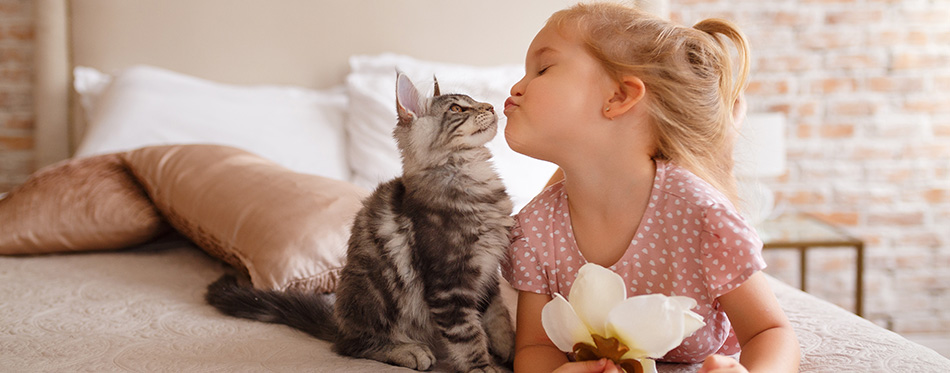Although cats have a reputation of being aloof and independent that doesn’t mean they don’t want to bond with you and enjoy a cuddle or a fuss. In fact, cats are actually adoring animals that thrive on love and affection. If you’ve just found yourself with a new cat or kitten this guide will provide you with everything you need to know to be able to hit the spot when petting your cat that can ultimately tighten your bond. Read on to understand where to pet and how to pet a cat to ensure that you and your feline develop the best relationship.
Do Cats Like to Be Petted?
To summarise: They absolutely do! If they are raised in a loving household and are socialized well, most cats love nothing more than to curl up on a lap and be stroked. If the right method and pressure is applied they will sit for hours purring away.
Nature Vs Nurture
It’s also important to acknowledge that there are cats that don’t like to be fussed. It’s simply in their nature to not want to be touched or picked up. They may come and enjoy an occasional scratch behind the ear but you probably won’t find them curling up next to you a lot.
Rescues
No one will ever know or understand the full extent of a cat’s life before rescue and adoption, some may not want to. Many cats, especially older cats, that have been through hard times may be reluctant to accept affection due to their upbringing but that doesn’t mean that petting is out of the question. They may just need time to adjust to their new surroundings, embrace their natural behavior, and settle in before they can feel safe and comfortable enough to relax.
Why Do Cats Like to be Petted?
For humans, petting cats can help to relieve stress and anxiety but it can also have similar effects on your feline friend too. Essentially, showing your cat affection physically can make them feel secure, safe, and relaxed.
Petting is a way for you and your cat to bond. Despite what some may say, your cat loves attention and it’s said that petting them reminds them of being groomed and comforted by their mothers. By replicating these moments, you’re effectively letting your cat know that you’re their family and you are a source of comfort for them.

Where Do Cats Like to Be Pet?
Unlike dogs, there are particular areas that cats prefer when being petted. By focusing on these areas you can build a strong bond with your cat and make them feel at ease and comfortable.
Head, Shoulders, Cheeks, and Tail
These are all areas that you should pay attention to in particular. Most cats tend to appreciate scratches and rubs around the chin, cheeks, and ears, although some cats enjoy head scratches especially, as this is said to be similar to the grooming and licking they used to receive from their mother. The base of a cat’s tail is also a favored spot for a scratch. The next time you pet a cat, try petting this spot and see their reaction – most cats love this!
Scent Glands
Felines have scent glands all over their bodies but there are areas that are particularly concentrated. These areas include a cat’s cheeks, forehead, and chin. In fact, when cats rub their head and face on furniture this is a way of spreading their scent, marking their territory. Also, when a cat rubs their head on you it’s a way of expressing love toward their human. This is known as head bumping and is a strong indication of a happy cat.
The specifically concentrated scent glands mentioned above can often rub off on their humans’ hands as they are being petted. This is likely to contribute to a cat’s affection towards their human as they will retain the familiar, individual scent.
Places To Avoid Petting
Cat’s Belly: A cat might plop themselves in front of you specifically to show you their belly but be warned: as tempting as it may be, it’s not an open invitation to pet it. Cats do this to display a sign of trust with you and is also a clear indicator that they are comfortable in their surroundings. Occasionally, cats may allow you to give their belly a little pet but generally, this is a very vulnerable area, so they are likely to not tolerate it for long.
Cat’s Feet: Feet are another area to avoid unless your cat responds well to being pet all over. Do not pet their feet unless you are confident that your cat likes it and that they won’t feel vulnerable, otherwise focus on petting their favored spots.
How To Pet A Cat
By now you know that petting a cat isn’t like petting dogs or other animals, especially if they are a new pet or unfamiliar cat. Fortunately, there are simple steps you can take to gain their trust and form a rapport.
Understanding Your Cat’s Behavior
Understanding cats can be difficult although guides such as this and other resources available on PetSide can supply you with the knowledge you need to establish what your feline companion is trying to tell you.
Meowing and Body Language
Cats meow at their owners in an attempt to communicate with them but a cat’s body language can also tell you a lot. For example, your cat might head bump you or brush up against you as a way of asking for pets.
Fun Fact: Kittens are known to be quite vocal with those around them, including humans, although adult cats don’t meow at other cats or kittens.
If a cat trusts you, you’ll find that they will willingly approach you, whereas cats who are not fond of human contact may skittishly retreat, swipe, or arch their backs and hiss as a way of warning you not to come closer. If you want to build trust, approach them slowly and let them come to you but never force yourself on them. You can also look at regulated petting sessions, once they become more relaxed, with treats as a way to form a gradual bond.
Once you know what to look for you will know whether it’s a good idea to pet them or not. Long-time cat owners are often in tune with their companions, enough to tell if they are enjoying their company or not, but it may be difficult for others. Follow this link to read about how cats show their affections towards humans.

How Do Cats Like to Be petted?
First, ask yourself: What do cats like? Initially, you may need to apply trial and error methods in order to find out what your cat likes. Generally, cats enjoy all of the techniques listed below but they may favor some more than others.
- Using one finger to gently stroke their nose in an upward motion
- Gently glide an open palm from the cat’s head to their tail. Make sure to apply gentle pressure and slow movements.
- Use your fingertips to gently rub their ears, chin, and cheeks
Cats will often provide you with enough positive feedback, in the form of purring or by “making biscuits” (kneading) to let you know that they are enjoying your attention and petting session.
When *Not* To Pet a Cat
A cat’s behavior will adequately reflect when they do not want to be petted. If your cat is particularly grumpy they could hiss, squirm, or swipe to warn you away but friendlier cats have simply been known to shrink away from an outstretched hand and show flattened ears and dilated pupils. If you notice these signs stop petting and give them their own space.

